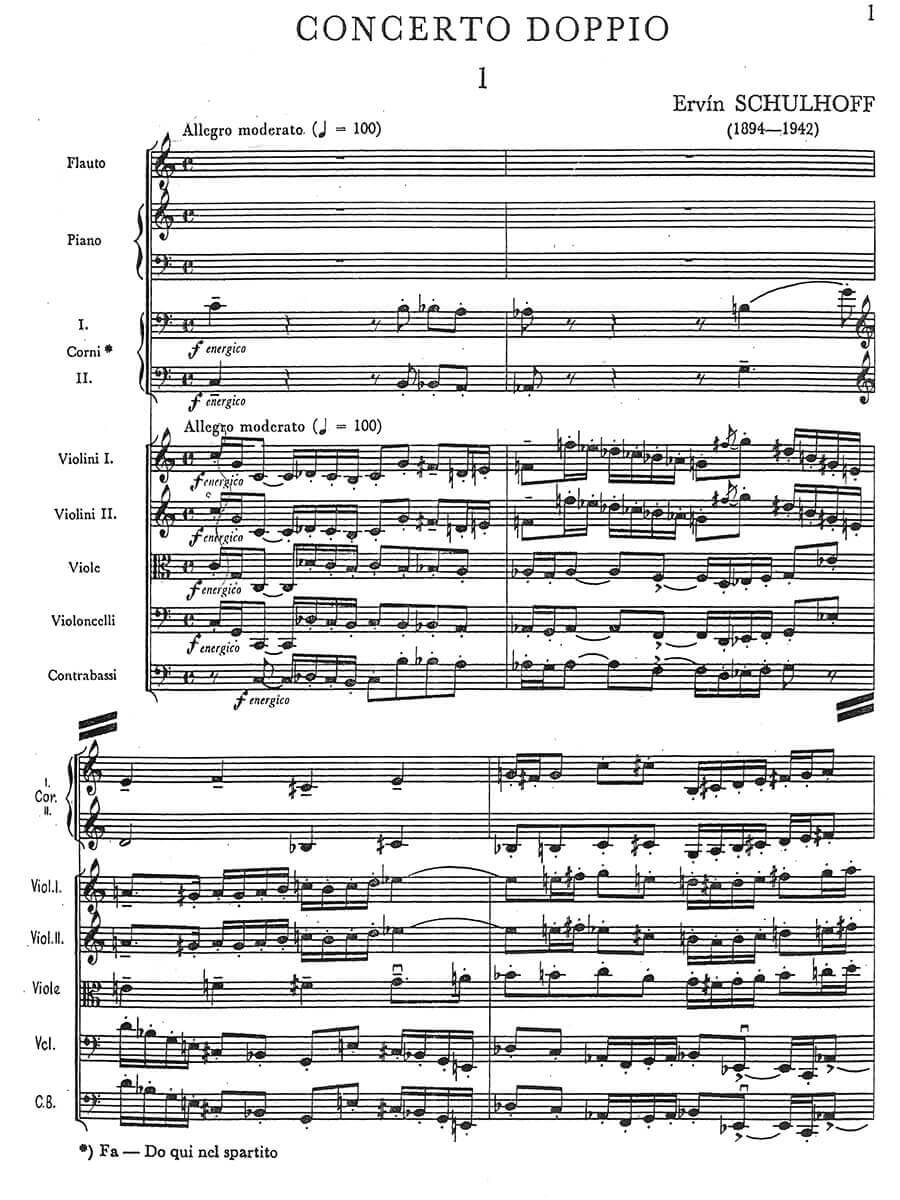Concerto doppio per flauto e piano con accompagnamento orchestra d’archi e due corni
Schulhoff, Erwin
23,00 €
Preface
Erwin Schulhoff
(b. Prague, 8 June 1894 – d. Weissenburg, 18 August 1942)Concerto doppio per flauto e piano con accompagnamento orchestra d’archi e due corni
(1927)I Allegro moderato (p. 1) – Più mosso (p. 6) – Cadenza (p. 31) –
Subito come primo tempo. Allegro moderato (p. 35)
II Andante (p. 37)
III Rondo. Allegro con spirito (p. 44) – Tempo di blues, quasi l’istesso tempo (p. 59) –
Allegro con spirito (p. 62)Preface (by Christoph Schlüren, November 2017)
Neoclassicism and ‘Neue Sachlichkeit’ emancipated themselves in the course of the 1920s as alternative stylistic directions to expressionism and impressionism within the scope of a zeitgeist that in the aftermath of the First Wold War catastrophe wanted to peel away the bourgeois illusionary world of the past epoch called ‘romanticism’. Many composers were now looking for orientation in models and topoi from the time of renaissance, baroque, and the Viennese classical era. The beginning of this development was marked by works such as George Enescu’s Second Orchestral Suite, Sergey Prokofieff’s ‘Symphonie classique’, or Igor Stravinsky’s ‘Pulcinella’ Suite. In the 1920 already, many works in concerto grosso manner – some of them explicitly called ‘Concerto grosso’ – emerged, written by composers such as Ernst Krenek, Heinrich Kaminski, Paul Hindemith, Darius Milhaud, Ernest Bloch, Julius Röntgen, Filip Lazar, Giorgio Federico Ghedini, the late Vincent d’Indy, Dimitri Mitropoulos, Eduard Künneke, or Erwin Schulhoff.Schulhoff was a pioneer in the fusion of jazz elements, and the present work is – in its final movement – one of the last before his radical stylistic change where jazz plays a rôle (jazz made its final appearance in his œuvre in the ‘Scherzo alla Jazz’ of his Second Symphony from 1932). The Doppio Concerto was written at a time when was still very successful and prolific as a composer and pianist. The main preceding works were: the ballet mysterium ‘Ogelala’ (1922), Concerto for piano and small orchestra, and ‘Five Pieces’ for string quartet (1923), string sextet and 1st string quartet (1924), 1st Symphony, 2nd string quartet, and the dance grotesque ‘Die Mondsüchtige’ (The Sleepwalkeress, 1925), the stage music to Molière’s «Le bourgeois gentilhomme», Cing Études de Jazz and 2nd sonata for piano (1926), Sonata for solo violin (January 1927), and Sonata for flute and piano (March 1927). Doppio Concert was written in Paris between March and early May 1927. Schulhoff had become friends with the flute virtuoso René Le Roy (1898-1985), a pupil of Philippe Gaubert who would later become solo flutist at the New York City Opera (1952-68) and afterwards professor at the Paris Conservatoire. Schulhoff immediately set to work on two projects that enabled them to play together: the Sonata for flute and piano, and the Doppio Concerto. The Flute Sonata was completed already on 12 March 1927. His work on the Doppio Concerto was interrupted by the spekling Divertissement for oboe, clarinet and bassoon that was finished within four days (24-27 March). Then he started parallely with his
Read full preface > HERE
Score Data
| Edition | Repertoire Explorer |
|---|---|
| Genre | Solo Instrument(s) & Orchestra |
| Size | 210 x 297 mm |
| Printing | Reprint |
| Pages | 78 |
